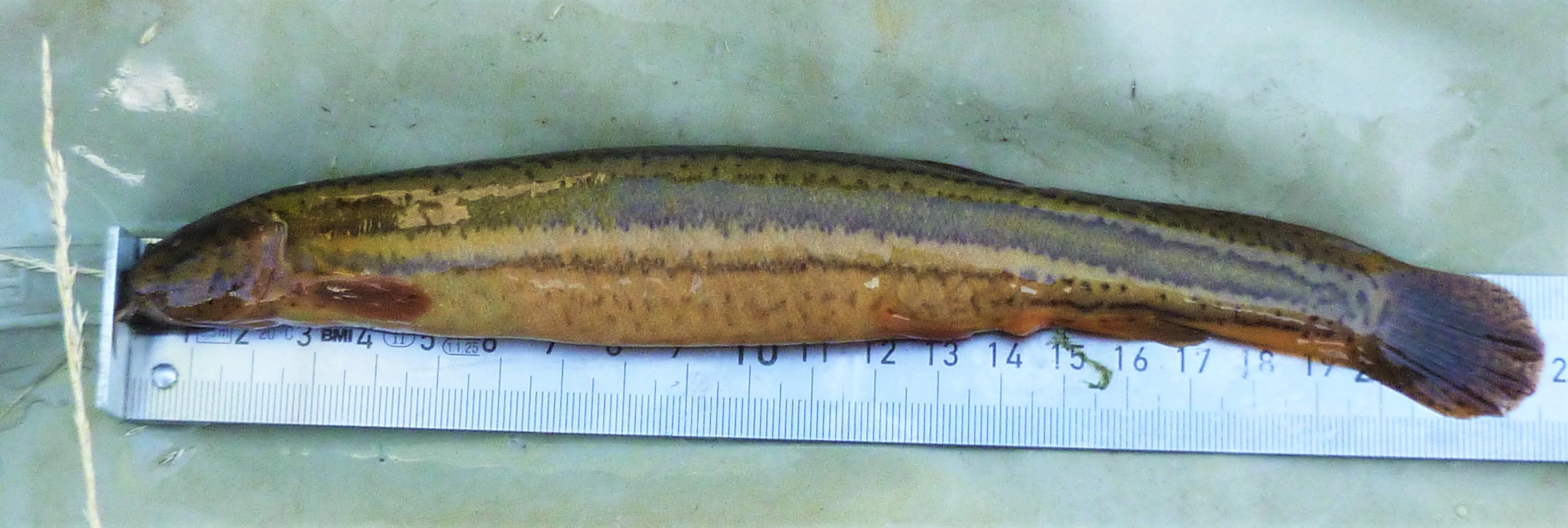Weatherfish
- Category: Fish fauna - species
- Published: Wednesday, 26 October 2016 12:08
- Written by Super User
Weatherfisch
Misgurnus fossilis, Linnaeus, 1758
Species description
Body of weatherfish is elongated and slightly flattened laterally (Photo 1). Scales are embedded in the skin. The species has a small head with small mouth. It has five pairs of barbells around the fleshy lips. Small eye are situated at the top of the head. Pigmentation of the body depends on the surrounding environment, can be from yellowish, olive-yellow to yellow-brown. There is a broad midlateral stripe from operculum to caudal base and irregularly distributed areas of pigmentation on the head, ventral half of the body, and fins (Nalbant 1963, Opalatenko 1974, Geldhauser 1992).
The species is sexually dimorphic: males are characterized by triangular pectoral fins with broadened first ray and they exhibit vertical swellings of the flanks behind the dorsal fin. Females reach larger size and their pectoral fins are rounded (Boroń 2000, Boroń et al. 2002).

Weatherfish is on the list of animals being under partial protection in Poland (Regulation of the Minister of the Environment of 6 October 2014 on the protection of animals species, Journal of Laws 2014, item 1348). It is also a species of the European Community interest and therefore it is listed in the Annex II of the Habitat Directive (Council Directive 92/43/EEC of 21 May 1992 on the conservation of natural habitats and of wild fauna and flora).
Biology
Weatherfish reach sexual maturity when it is two years old. It spawns from April to June at water temperatures between 16 and 20ºC. The spawning is very short and lasts from two to five hours. Adults are brightly coloured during the breeding season, male’s frontal edges of fins and barbels turn red. Fertility of females is dependent on the individual fish weight. The spawning takes place on muddy bottom and/or in dense vegetation. After 48 hours, also larvae hide in vegetation attaching to the plants until the yolk-sac content is fully absorbed. In addition, larvae develop external gills at that period (Gąsowska 1962). Weatherfish is a benthic omnivore that feeds generally on insect larvae, ostracods, molluscs, cladocerans, and detritus.
Habitat
Weatherfish inhabits slow-flowing rivers, but can also be found in shallow lakes, still pools, ponds, and ditches. In some of these environments, it is commonly found burrowed in mud, especially in dry periods, as it is able to survive in low oxygen conditions. It is able to gulp air, oxygen being absorbed through the walls of the gut (this explains specific sounds given when the fish is squeezed, which is expressed in the Polish name of the species, Kotusz 1995 and 2001). Urbanization, reclaiming of wetlands, and activities which result in increased river current, negatively impact the weatherfish populations (Olivia et al. 1968, Witkowski et al. 1999, Witkowski et al. 2009).
Distribution
Weatherfish occurs all over Poland, where formerly was very common. At present, it inhabits almost all lowland rivers (Kotusz 1996).
As a part of the project carried out by the Maritime Instiute in Gdańsk ”Pilot monitoring studies of marine habitats and protected species in 2015-2018", weatherfish is monitored at 5 sites:
- Jezioro Łebsko,
- Ujście Redy (Beka Reserve),
- Ujście Wisły (Mewia Łacha Reserve),
- Jezioro Bukowo,
- Jezioro Gardno.
References
- Boroń A. 2000 Piskorz Misgurnus fossilis, 1758. (in:) Brylińska M. (ed.). Ryby słodkowodne Polski. PWN, Warszawa, p. 347-350.
- Boroń A., Kotusz J., Przybylski M. 2002. Koza, Koza złotawa, Piskorz, Śliz. Wyd. IRS Olsztyn.
- Gąsowska M. 1962. Krągłouste i ryby. Klucz do oznaczania kręgowców Polski. PWN, Warszawa.
- Geldhauser F. 1992. Die kontrollierte Vermehrung des Schlammpeitzgers (Misgurnus fossilis, L.). Sonderdruck aus Fischer & Teichwirt 43: 2-5.
- Kotusz J. 1996. Ochrona gatunków piskorzowców (Cobitidae, Cypryniformes) w Polsce na tle ich występowania i status w innych krajach Europy. Zoologia Poloniae 41: 147-155.
- Kotusz J. 1995. Morphological characteristics of the mud loach Misgurnus fosillis (L) (Pisces: cobitidae) from the mid Odra and Vistula River baśni. Acta Ichthyol. Et Piscat. 25: 3-14.
- Kotusz J. 2001. Piskorz Misgurnus fossilis L. (in:) Głowaciński Z. (ed). Polska czerwona księga zwierząt. Kręgowce. PWRiL Warszawa, p. 315-316.
- Nalbant T.T. 1963. A study of the genera of Batiinae and Cobitinae (pisces, Ostariophysi, Cobitidae). Trav Mus. Hist. Nat. 4: 343-379.
- Oliva O., Hrabe S., Lac J. 1968. Stavovce Slovenska I. Ryby obojzivelniky a plazy. SAV, Bratislava, p. 16-227.
- Opalatenko L.K. 1974. Kmorfobiologicoj charakteristike vjunovych (Cobitidae) Verchnevo Dniestra. Vest. Zool. 6: 56-62.
- Witkowski A., Błachuta J., Kotusz J., Heese T. 1999. Czerwona lista słodkowodnej ichtiofauny Polski. Chrońmy Przyr. Ojcz. 55 (4): 5-19.
- Witkowski A., Kotusz J., Przybylski M. 2009. Stopień zagrożenia słodkowodnej ichtiofauny Polski: Czerwona lista minogów i ryb – stan 2009. Chrońmy Przyr. Ojcz. 65 (1): 33-52.





